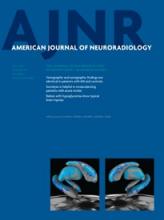In a recent meta-analysis, intraparenchymal hemorrhage secondary to treatment by a flow-diverter stent (FDS) was reported in 3% of the cases.1 Most of these hemorrhages were periprocedural complications. More surprising cases of delayed ipsilateral hemorrhage have been reported lately in patients treated with the FDS.2 The causes of such delayed complications remain unclear. We aimed to share our experience with 2 additional cases of delayed and distant hemorrhage in patients treated by FDS.
In our department, 45 consecutive patients were treated with an FDS (Pipeline Embolization Device [PED; Covidien, Irvine, California], n = 30; Silk [Balt, Montmorency, France], n = 10; and NeuroEndoGraft, n = 5 [Stryker Neurovascular, Fremont, California]) for 47 intracranial aneurysms from January 2009 to February 2013. Among these patients, 2/45 (4.5%) experienced a delayed hemorrhage (>7 days) after discharge, whereas no complication occurred during the procedure or during the hospital stay. These patients were respectively a 37-year-old woman treated for an unruptured bilobulated 6 × 3 mm left carotid-ophthalmic aneurysm with a PED and a 52-year-old man treated for an unruptured 10-mm left vertebral fusiform aneurysm with a Surpass stent. Both patients were loaded with clopidogrel (75 mg/day) and aspirin (160 mg/day) 5 days before the procedure; the same antiaggregation platelet therapy was continued after the procedure. The efficacy of the antiaggregation therapy was checked with the Multiplate analyzer (Roche, Basel, Switzerland) in both patients. The first patient experienced a sudden onset of headache associated with right hemiparesis and Wernicke aphasia at day 7 after the procedure, related to a spontaneous left temporal hematoma. The second patient had sudden headache associated with kinetic cerebellar syndrome at day 7 after the procedure; vermian hematoma was seen on CT. Both patients had patent FDSs without findings of acute bleeding on angiographic imaging. Clopidogrel was stopped in both patients; only the aspirin was continued. Both patients fully recovered and were discharged at days 22 and 18, respectively.
Cruz et al2 reported an ipsilateral delayed hemorrhage with a frequency of 8.5%. However, this high complication rate may be explained by the relatively small population studied (47 patients).3 In contrast to the 2 cases reported by Cruz et al, our 2 hemorrhagic complications occurred >1 week after the treatment. The causes of such delayed distant hemorrhages remain unclear and are still a matter of debate. Perforation with the distal wire of the delivery system of the FDS or during exchange maneuvers may explain some hemorrhagic complications (within 48 hours after the procedure) but is unlikely to explain delayed bleeding as observed in our 2 cases after 1 week. Moreover, no exchange maneuver was performed in our 2 cases, and the bleeding site was distant from the wire tip of the delivery system.
Stroke with subsequent hemorrhagic transformation has also been suspected as a possible cause of such delayed hemorrhage. This mechanism may be a potential explanation because hemorrhages were ipsilateral to the treatment. However, no clinical symptom suggestive of stroke was reported in our 2 patients before the diagnosis of hemorrhage. Cruz et al2 hypothesized that the hemodynamic changes and altered arterial compliance of the parent vessel by the PED may cause delayed hemorrhage.2 However, no flow study has been published to support this hypothesis, to our knowledge. Another potential cause for such delayed bleeding, especially in the second case, is the hypertension that may precipitate, under dual antiaggregation platelet therapy, spontaneous bleeding.
There is no consensus on the management of such delayed hemorrhages. In our 2 cases, we stopped the clopidogrel and continued the aspirin; no in-stent thrombosis occurred subsequently.
In conclusion, even if the causes of such delayed complications remain unclear, interventional neuroradiologists should be aware of the possibility of delayed and distant hemorrhage in FDS treatment and thus should inform the patient of this risk before treatment.
REFERENCES
- © 2013 by American Journal of Neuroradiology












